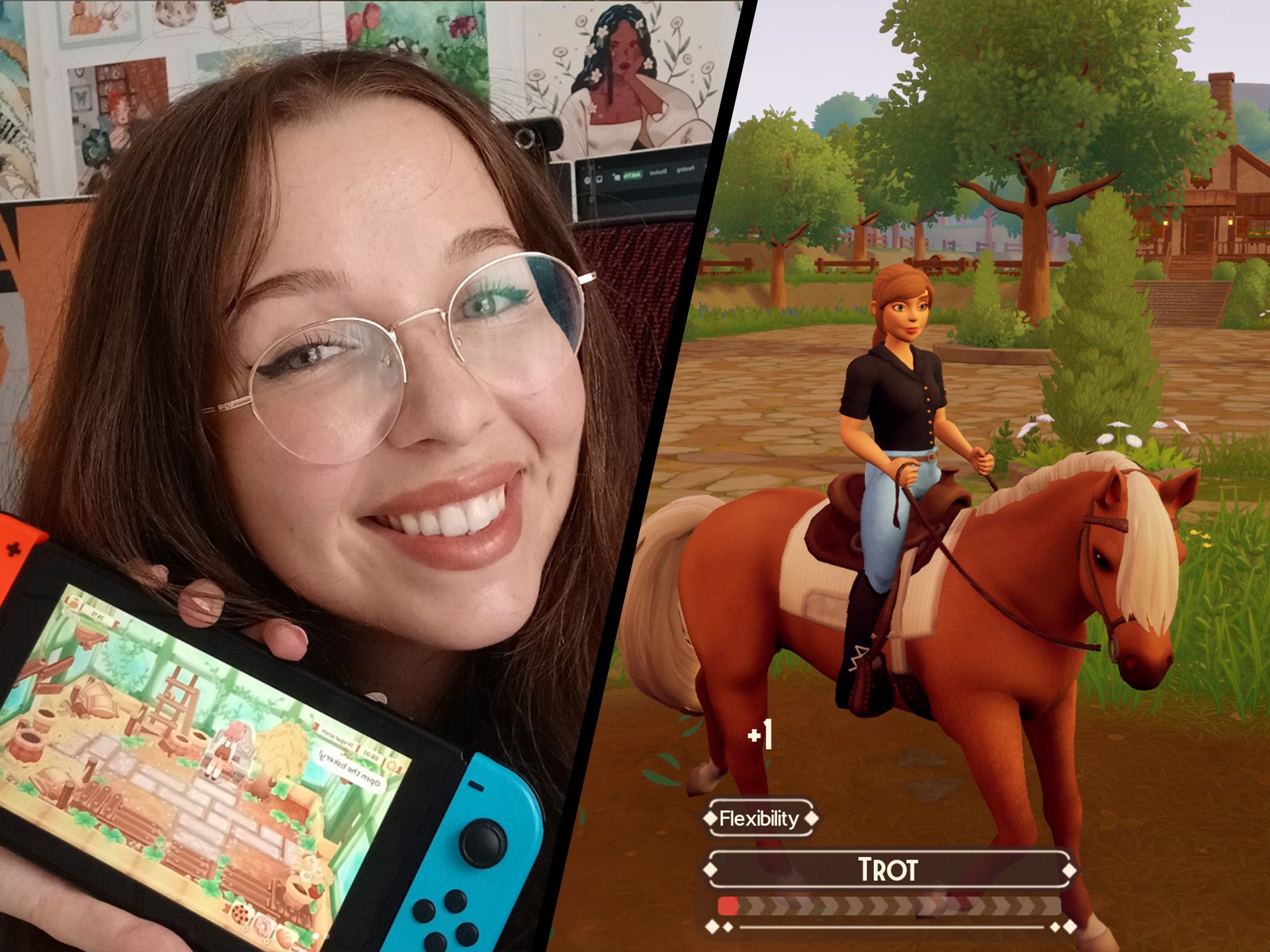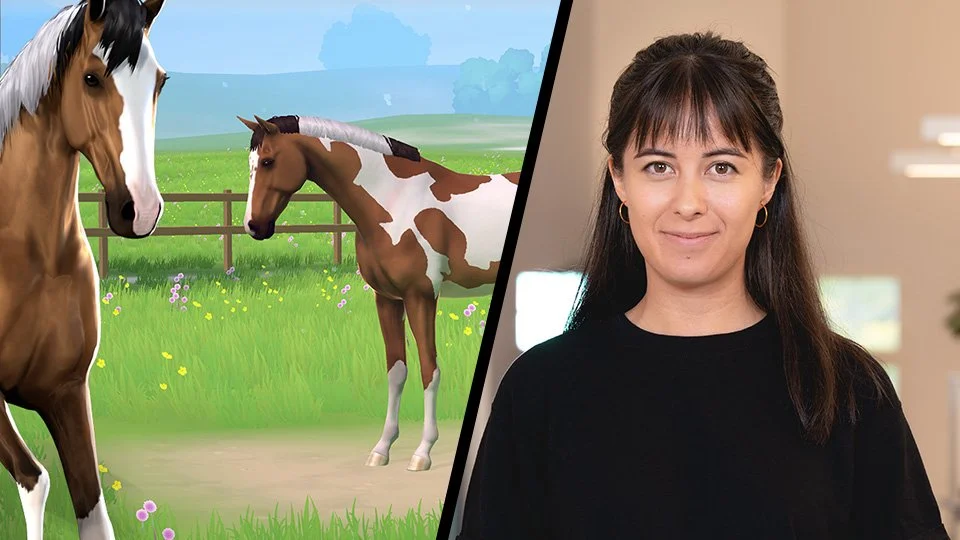Korion Interactive – How New Creative Minds bring Fresh Wind into Kids' Horse Games
Gamescom 2022 in Cologne was an exciting event for me – not only were Aesir and Microids showing Horse Tales to the public for the first time, it was also the first major industry event I’ve gone since The Mane Quest really started taking off and gaining acclaim, after so many events couldn’t take place due to Covid in 2020 and 2021.
Meeting the team of Korion Interactive was one of my highlights though: I had just briefly introduced myself and TMQ to a developer whose game I enjoyed and had some horse mechanics feedback for, when I turned to find about five people in matching Moorhuhn T-shirts standing behind me basically going “Hi, we’re so excited that we found you, we love The Mane Quest and we’re making horse games now.”
Over a brief and excited conversation, I found out that this troupe of passionate game creators were Korion Interactive, and that they were the dev studio behind the newest Bibi & Tina and My Riding Stables games. And perhaps most interestingly: that they’d read and applied various bits of feedback from my reviews of other games in these franchises, and undertook efforts to truly improve upon previous iterations, within their significant time and budget constraints.
With the release of My Life: Riding Stables 3 in early December, Korion’s Artist and Game Designer Emily Leifheit got back in touch with me to tell me more about how they became horse game makers and what challenges they faced along the way.
Indie, Serious and Work-for-Hire
The Korion Interactive Team
We’re joined by CEO Michael Blatz, Creative Director Adrian Rees and Developer Moritz Umfahrer. The total Korion Games team consists of seven people, with another branch of the company focusing on Robotics instead, under the leadership of the former CEO. The company was first founded in 2007, and Michael and Adrian have been part of it since 2013.
In that time, Korion has switched its focus more than once: They’ve created Serious Games for the French-German public service channel ARTE, ported games from PC to Switch for other studios, and tried their hand at an independently published early access game, albeit with limited success.
Over the past year, the studio’s specialty has shifted once again: through repeated Work-For-Hire arrangements with long-established publisher Markt+Technik, Korion has found a new strategy for success.
“We had been working on an adventure game prototype for a different publisher,” says Michael, but when that didn’t go through they were referred to Markt+Technik as a potential partner. “Markt+Technik was looking for a studio to create a digital version of Mensch ärgere dich nicht for them, and we ended up getting that job.”
Mensch ärgere dich nicht – a well known German board game known in English as Ludo or Parcheesi – was only the first of the studios productions backed by M+T. Contracts for what would become Bibi & Tina: New Adventures with Horses, Moorhuhn Xtreme and My Life: Riding Stables 3 followed suit shortly thereafter.
Bibi & Tina
Final game screenshot.
Final game screenshot.
The first task on Korion’s plate when starting work on their Bibi & Tina game was defining the project concept themselves, in collaboration with publisher and IP holder.
“Designing the game was part of the work order,” Michael tells me. “There were some pre-defined specifications – like the minigames and racing mechanics – that had to be part of it based on the German state funding grant.”
To research for the project, the team played the previous Bibi & Tina video games and searched for player reviews to add to their own learnings and goals for improvements. That is how they came across The Mane Quest.
“We found some of our own feedback reflected in the TMQ reviews, that was interesting,” Emily explains. “But it was also a completely new perspective: We were able to conduct additional research about horses that we wouldn’t have known to look for otherwise, like how some breeds are limited to specific coat colors.”
Nobody on the Korion team had a particularly “horsie” background before these two projects.
Big Tina is watching you. (Engine Editor screenshot)
The core development time for Bibi & Tina: New Adventures with Horses was just five months. “That was pretty crisp,” the team admits. Previous titles in the Bibi & Tina and My Riding Stables game series were developed by Independent Arts Software, whose source code and assets were made available to Korion.
“We were able to reuse a few models and the design for the minigames, but the code was mostly written from scratch in the end,” says Moritz. “Independent Arts Software also supported the project with QA-work though, especially where platform compliance and technical requirements were concerned.”
Work in progress screenshot
Despite the limited time and budget, Korion is happy with what they achieved with Bibi & Tina: New Adventures with Horses, and considers the project an important stepping stone on the way to their next horse game.
“One thing we pushed to include and got done was to include the original voice actors of the Bibi & Tina audio plays,” says Emily.
The Korion team also insisted that the game would be released on Steam, in addition to the console target platforms – not only for the sake of the company’s own portfolio, but also because of Steam reviews as a built-in platform for user feedback, which would help them in the future.
Riding Stables and Applied Learnings
With almost eight months of development time, Korion’s second horse game would be significantly bigger in scope than their first – and yet still rather tiny compared to most PC and Console games. Although the project would eventually be released internationally as My Life: Riding Stables 3, the game’s German version uses the Wendy title. With less narrative focus than in Bibi & Tina, this second Korion horse game would have fewer direct ties to its underlying intellectual property.
“We had to make sure you could build ‘a Wendy’ in the character creator,” says Michael, “but we had a lot of liberty otherwise.”
Work in progress screenshot.
Concept sketch for the stable.
Korion put those liberties to use by cutting a handful of features that were present but not particularly enjoyable in the previous My Riding Stables titles. “We decided not to revisit the Guest House and Horse Breeding mechanics,” Emily tells me. “If done right, those features would move the game more into an economic simulation direction, which wasn’t a great fit for our young target audience, and not really achievable with our dev time and budget.”
“We focused on training and tournaments instead,” Michael elaborates, “since those mechanics are more closely linked to the horse, and encourage direct interaction with the world.”
Work in progress screenshot.
Work in progress screenshot.
For their Riding Stables title, Korion revisited past games in the series and studied reviews in order to gather and prioritize feedback and possible improvements. “We played the 2008 game because of the TMQ review for it, and ended up taking inspiration from it,” says Emily. “We liked that that game used experience pickups in the world for training horses, and did something similar in our successor.”
“We also let the player turn the camera while riding, and added that you can take off the saddle in the stables after reading those requests on The Mane Quest,” adds Adrian.
One thing they weren’t able to change even after knowing its problems was the Horse Animset Pro animation pack. “We would have liked to tweak the animations a bit based on your feedback,” Moritz tells me, “but that ended up being out of scope too.” The newer Horse Herd asset pack wasn’t an option yet for the Unity-based projects.
Work in progress screenshot.
Work in progress screenshot.
Working Relationships
I ask the team how the collaboration with Markt+Technik worked out for them. “We could bring up a lot of constructive discussions,” Michael says. “Doing multiple projects with MuT builds a certain trust between the companies. That gave us plenty of room for suggesting and implementing changes.”
One thing Korion had no influence over is the game’s choice of title: I bring up how ridiculous I find it that the follow-up game to My Riding Stables: Life with Horses and My Riding Stables 2: A New Adventure is called My Life: Riding Stables 3.
“It’s not our fault,” the team says, laughing. Michael goes on to explain that they had no creative control over the game logos either. “We consider it relevant for our portfolio though,” he adds. “For future projects, having a say in title and logo is something we’d like to push for.”
Another goal is to shift the working conditions from a pure work-for-hire order to a revenue share model. The latter would also give Korion more insight into the games’ financial performance, which they currently don’t have at all.
After Bibi & Tina and My Life: Riding Stables 3, as well as Moorhuhn Xtreme and Mensch ärgere dich nicht, Korion is happy to continue their collaboration with Markt+Technik, and perhaps even to tackle more horse games in the future.
“None of us were big horse lovers when we started out,” says Emily, “but we sort of slipped into this, and now we try to do the topic justice as best we can, without extensive background knowledge.”
“We definitely had fun during the research and development,” adds Michael. “We’re not necessarily horse fans, but our team is passionate for games and product quality.”
Korion added more pick-ups to the world to reward the player for exploring. Final game screenshot.
The massage minigame has made a comeback in the latest Riding Stables. Final game screenshot.
Outcomes
I have not gotten around to actually playing Korion’s horse games yet – between these and Horse Club Adventures 2, my “to be reviewed” stack is once again piling up – but from my chat with the team I expect a more rounded experience that doesn’t try to do everything at once on its tiny budget. And at the risk of repeating myself across articles, I am a big fan of keeping games’ scopes contained and doing a few things well rather than spreading ones resources too thin.
The kids’ low budget retail market isn’t necessarily where adult horse game players try to get their fix of horsie game content, and I see little engagement with these types of games in the TMQ-related communities. Still, I hugely value even slight improvements in these titles for the sake of the young horse enthusiasts growing up after us.
But most of all, learning that my TMQ work is so directly helpful to those trying to make better horse games, is an absolute joy.

























For a long time, new horse game options for PC and Console players have been few and far between. In Fall 2022 however, our niche genre has gotten a whooping four new releases. Full reviews may be coming at some point in the future, but for now, let’s have a quick look at what each of these games offer: